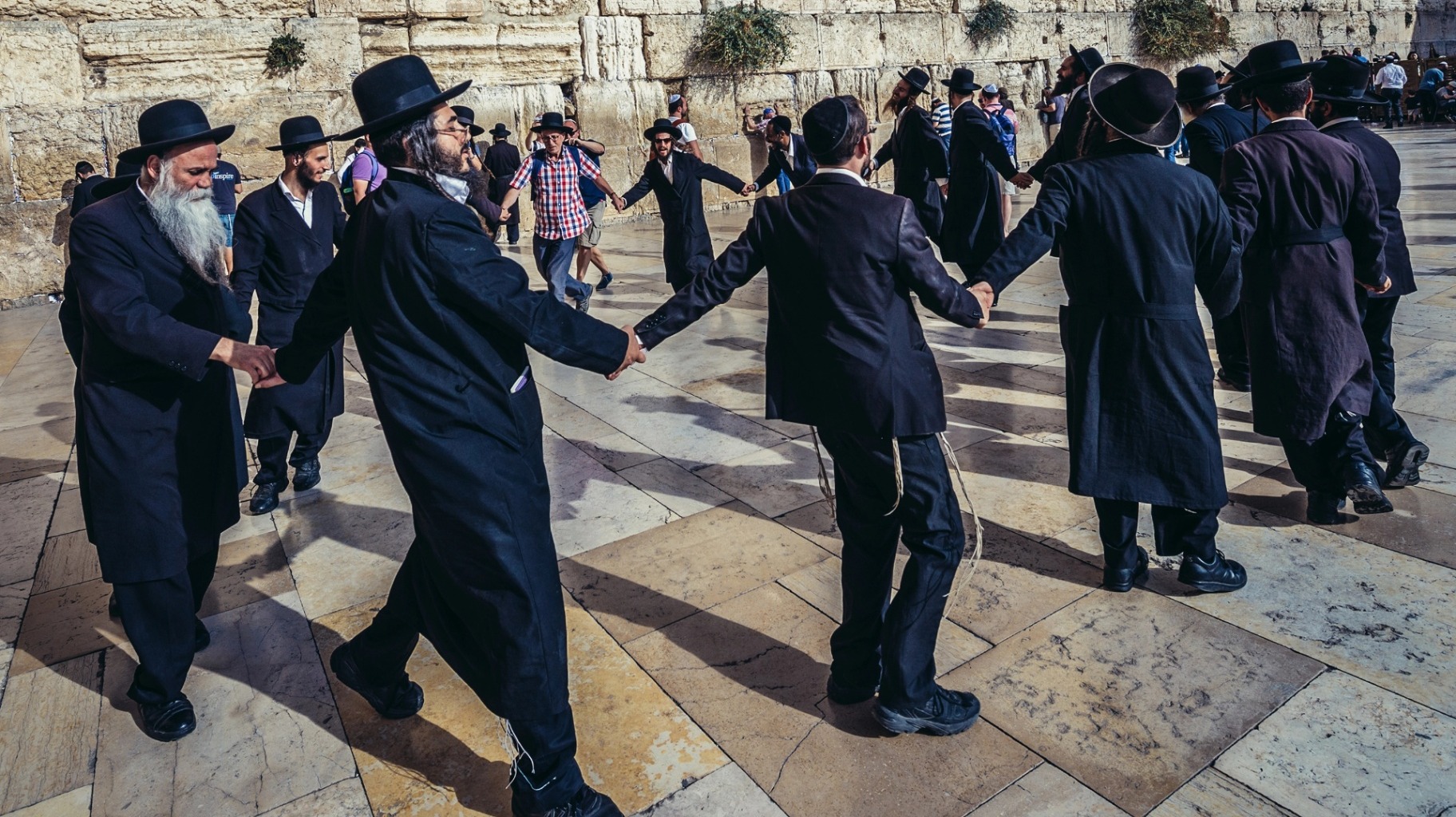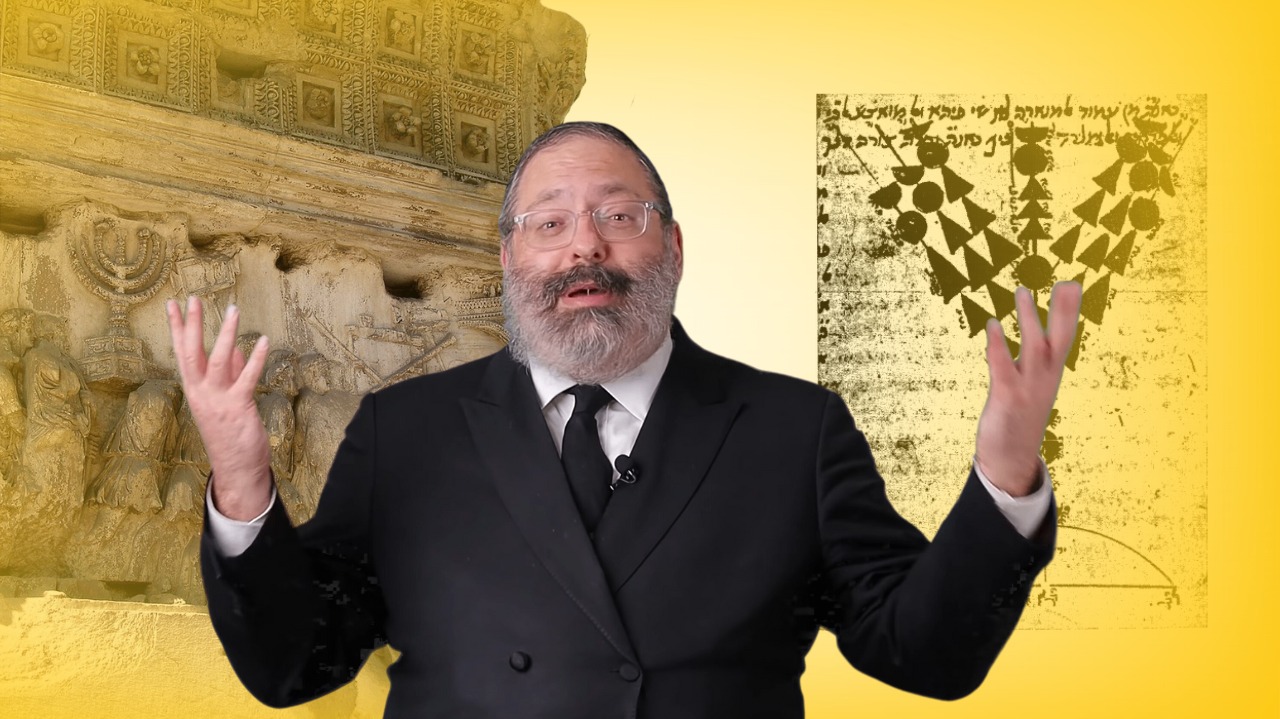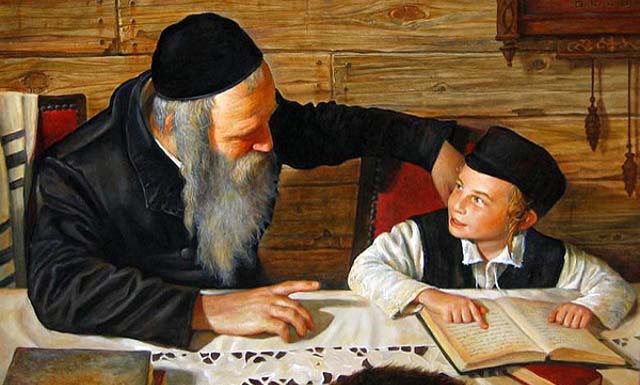What the Jews Did Not Tell the Dalai Lama
The Secret of the Ark’s Immobile Poles: Seven Perspectives on One Mitzvah
Class Parshas Terumah
- February 25, 2012
- |
- 2 Adar 5772
Rabbi YY Jacobson
5810 views- 50Comment
- Call-in
Listen to the class on the phone
Call +1 (845) 201-1933
When prompted, dial the ID number below.
48 MP3 MP4 Source Sheets - Copy Embed
Dedicated by David and Eda SchottensteinIn the loving memory of Alta Shula Swerdlov and in honor of Yetta Alta Shula, "Aliya," Schottenstein
Class Summary:
In this week’s Torah Portion, the Jews are charged with mission impossible: Build a finite home for an infinite G-d. Yet, G-d chooses to “rest” in this relatively humble abode, and most intensely in the Holy of Holies, the location of the Ark.
The Ark was a gold-plated box containing the Tablets, the Torah, given to Moses at Sinai, and had two poles, one on either side, which enabled the Kohanim, the priests, to carry it during travel.
In this class, we will analyze the timeless spiritual meaning behind the enigmatic prohibition forbidding the removal or dislodging of the Ark’s two carrying poles.
Tags
Categories
Class Parshas Terumah
Rabbi YY Jacobson
- February 25, 2012
- |
- 2 Adar 5772
- |
- 5810 views
Dedicated by David and Eda SchottensteinIn the loving memory of Alta Shula Swerdlov and in honor of Yetta Alta Shula, "Aliya," Schottenstein
Related Classes
Please help us continue our work
Sign up to receive latest content by Rabbi YY
Join our WhatsApp Community
Join our WhatsApp Community













Please leave your comment below!
Anonymous -1 year ago
I listened to your shiur about the Aron's poles. I understand the mitzvah that the poles can never be removed (to the extent that someone with my background can understand it), but if the drawings in the Mishkan book that I looked at are accurate, the handles/poles are wider/thicker at the ends than they are in the middle. So it seems that the poles couldn't be removed even if one wanted to do so. Furthermore, that raises the question, how did they insert the poles into the rings if the ends of the poles were so thick?
Reply to this comment.Flag this comment.
YYJ -1 year ago
Yes, this is from Talmud Yuma 72a. Here is a link to the Talmud with English:https://www.sefaria.org/Yoma.72a.11?lang=bi
Because of the prohibition, hence they ensured that the edges were thicker, so they would indeed not fall out.How did they get in? Either through squeezing (rashi ibid.), or maybe they made the rings after the poles were there already. But it does not seem that way.
Reply to this comment.Flag this comment.
Evelyn -3 years ago
Thank you Rabbi
i try to have you accompany my 2 mile walk so I can learn amidst Hashem's outdoor beautiful bounty... this class was especially meaningful to me - as I found that my brother- once a Baal Tshuva- now a charedi in Jerusalem - both of us children of Holocaust survivors- who grew up without Torah - I envisioned'my brother' as the 'portable' Torah and opened its pages to me!
thank you for all that you do to keep Torah spreading and renewing Jewish lives
evelyn fabrikant
Reply to this comment.Flag this comment.
Isaac -4 years ago
Here is the myth: The queen of the British Empire, Victoria, and her husband Prince Consort Albert were visiting family in Hanover, Germany, when the unexpected happened; Queen Victoria went into labor two months before her due date. Moshe Montefiore, who was a financial advisor to the British government, arrived at the Court of Hanover during this time, and found the members of the Court in an uproar. The premature birth seemed inevitable, but it would pose a major problem.
If the baby was born on German land, his right to succeed the throne may be endangered since he would then be considered a German citizen. Later that afternoon, Montefiore went to daven in the shul of Rabbi Nathan Adler, a Rav in Hanover. After mincha, he related the dilemma of the British Royal family to Rav Adler, and Rav Adler had a brilliant suggestion. He advised that the Queen be placed on an English ship, which would travel three kilometers from German land until it reached international waters.
The baby, who would hopefully cooperate with these plans, would be born on a British ship in international waters, and would thereby be considered as if he was born on British land. Montefiore rushed to the Court to relay this advice, and the royal attendants rushed Queen Victoria to the British warship, the Arc Royal.
Later that night, the Queen gave birth to a boy, who was destined to become King Edward VII. Many years later, Queen Victoria saw a notice from the Dukes Place synagogue in London. The shul was seeking applicants for a rabbi, which was considered a very prominent position. Many rabbis from all over the world applied for the position, including Rabbi Samson Raphael Hirsch.
The Queen, however, was partial to a certain applicant, whose name she recognized from years before, Rabbi Nathan Adler. She sent a note to the shul, stating her preference for Rabbi Adler, who had come to her aid many years before. The shul did choose Rabbi Adler, but the Queen was not yet satisfied. She proposed that Rabbi Adler become the Chief Rabbi of England, or even of the entire British Empire. A bill was voted in Parliament to decide whether the British Empire should elect a chief Rabbi, and a majority chose Rabbi Adler as Chief Rabbi of the British Empire.
Rabbi Adler filled the post of Chief Rabbi for forty-five years. And throughout Queen Victoria's long reign (she lived until eighty-two), the Jews were treated positively and were graced with more rights than Jews in other European countries. (Chance Encounters M.L. Mashinsky) But I saw this response: I just read your story on "The Rabbi Who Saved the Monarch": I am British by birth, so it was obviously of interest to me.
Unfortunately, a little bit of research revealed that the story is most definitely not true. Sorry! Please read the exchange below for more details. I suggest that you either replace the story or put in a disclaimer that it is "cute but not true".
Thanks, Nachum Lamm recounts the fable (immortalized in a Mesorah Press book,'Chance Encounters' by M. L. Moshinsky) of how Rabbi Nathan Marcus Adler, helped by Moses Montefiore, caused Queen Victoria ("visiting theheim") to give birth (according to the book, to the future King EdwardVII, her successor) on a British ship, thereby ensuring the correct citizenship for her child. As a reward, "She was so grateful [sic] for the advice that she made him Chief Rabbi of the UK". Some facts: All of Queen Victoria's nine children were born in England - eightin Buckingham Palace, and one at Windsor Castle. None were born on a ship ...
The ship is named in the book as the "Arc [sic] Royal". The first Royal sank in the seventeenth century; its successor was an aircraft carrier built-in 1938. N. M. Adler was *elected* Chief Rabbi in 1844 by an assembly of representatives of the three most important London congregations ("....it was found that he had been almost unanimously elected, with 121votes out of a total of 143.")
However, history does record the following (no doubt the unembellished kernel of the 'ma'aseh'): "The recommendations which he had presented were of the most cordial nature: it was said that they were backed by private communications from queen Victoria's uncle, the Duke of Cambridge, who had come into contact with him as Viceroy of Hanover.
Because of his German origin and upbringing, the Prince Consort found him congenial company; and family legend [Adler family legend -- PS] tells how he, an expert in the problems of nationality, warned the Queen on a historic occasion of the legal complications that might ensue were any of her children born in Germany." (C. Roth, "History of the Great Synagogue'). Moses Montefiore is nowhere to be found ... Interestingly, one of the defeated candidates for the post of chief rabbi was a young Rabbi S. R. Hirsch, whose application letter for the post is printed in the Kluger edition of Hirsch's Teshuvot, etc, "Shemeshmarpei". Next, Mr. Lamm tells us that the Queen heard Rabbi Adler duchaning(cf other postings -- not recorded whether this was Mincha, Neilah,Shabbat/Yomtov ...), and incorporated the chant into a Royal funeral lament. This, too, has a historical kernel, although apparently not because Victoria heard it in the ezras noshim, as Adler died in The Jewish Encyclopaedia records (sv Blessing, Priestly) that the niggun used in England was associated particularly with days on whichYizkor was said:
"From this, it has come to be widely known as "NiggunMetim" or "The Chant of the Dead." Its recent history is of particular interest. Developed with insight and feeling by Cantor Naumbourg of Paris, an instrumental arrangement was published in E. Pauer and L. Cohen's "Traditional Hebrew Melodies," London, 1896, which attracted the attention of the late Queen Victoria and was played as the introductory voluntary at several memorial services of the British royal family." Finally, the closer association with Queen Victoria was of NathanMarcus Adler's son, Hermann Adler. Hermann Adler, who served as delegate Chief Rabbi' in the years when his father was indisposed and had retired to Brighton, affected the dress and manners of an Anglican bishop. Queen Victoria referred to him as 'my Chief Rabbi'.
I would like to thank Mr. Lamm for causing me an entertaining hour or sorooting through some books and the internet, and apologize, if apologybe needed, for spoiling the story! Paul Shaviv, Toronto.
Paper read by Mr. Marcus N. Adler, at the Jewish Institute in London, on the 6th of June, 1909, on the occasion of the Jubilee of the Chief Rabbi. Reprinted from the JEWISH CHRONICLE. “The story of Rabbi N. Adler and the Queen has been circulating in the Adler family but I also heard it from Rabbi Moishe Schneider zt”l during one of his mussar schmuessen long before I joined the family,” writes HaRav Yitzchak Kaufman of B’nei Brak, who is married to a descendant of Rav Nathan Adler. He concludes, “Today, in B’nei Brak alone, there are over 300 yungeleit, descendants of the family, learning in local kollelim and yeshivos. The patriarch of the family did a favor for the Queen, resulting in his emigration from Germany to England, where he founded generations of Torah-true descendants devoted to a life of Torah and avodas Hashem.” Luckily this gives its source, namely "(From “THE ADLER FAMILY -- ITS GENEALOGY; WITH SOME REMINISCES”) described as "Paper read by Mr. Marcus N. Adler, at the Jewish Institute in London, on the 6th of June, 1909, on the occasion of the Jubilee of the Chief Rabbi. Reprinted from the JEWISH CHRONICLE." As it turns out, The Adler Family - It's Genealogy with Some Reminisces is available to read or download. Now, I was expecting some variation of this story to appear in it, but although there is a section on Montefiore, nothing even remotely like this story appears. I figured I'd better look up the paper in the Jewish Chronicle since this pamphlet was reprinted from that newspaper. Sure enough, the entire speech is printed in the June 11, 1909 issue, but it is identical to the pamphlet, which you can read yourself quite easily. So what gives?
Now, the story is strange for a number of reasons, not the least of which is that there seems to be no record or hint that Edward was born on a British ship. In fact, his page on Wikipedia says that he was born at Buckingham Palace. Furthermore, he wasn't Victoria's eldest, but her second child. It is entirely possible that some sort of Adler family legend to this effect existed, but it surely wasn't mentioned by his son Marcus Nathan (who does mention family lore that they are descended from the compiler of Yalkut Shim'oni -- however, he examines that claim critically, as his father no doubt did or would have). In fact, the source is probably from outside the Adler family, I imagine.
The oral source the author gives, HaRav Yitzchak Kaufman" of B’nei Brak, who is married to a descendant of Rav Nathan Adler" relates that he heard this from Rabbi Moishe Schneider in a mussar schmuess long before joining the Adler family. It may well be that the 300+ strong Adler yungeleits in B'nei Brak tell this story, but it seems to me more likely that it came to them through mussar schmuessen and the like rather than from anything that the family patriarch ever said or did.
That said, IIRC the Chief Rabbi was known to the royal family from his Hanover days -- a historian writes that "Whilst Rabbi in Hanover, he became acquainted with Prince Adolphus, Duke of Cambridge, regent of the province, who is thought to have recommended him for the post of Chief Rabbi in Britain" -- and perhaps Victoria did pen a note to the Duke's Palace synagogue supporting his candidacy.
Incidentally, Montefiore's diaries (from 1812-1883) don't seem to know of anything remotely like this incident or mention the HMS Arc Royal or know that he was in Hanover at any time besides 1857 and 1872hat's the deal with the R. N.M. Adler-Queen Victoria story? Some additional light.
Follow up to this post: A really odd Godol story about Rabbi Nathan Marcus Adler, Moses Montefiore, and Queen Victoria. First the background. Although highly Teutonic, the Kingdom of Hanover was a territory under British sovereignty. In fact, the kings of Hanover were British royalty. See Monty Python sketches with Victoria speaking German. In any case, this is the British connection with Hanover. Here are some excerpts from the article "Chief Rabbi Nathan Marcus Adler (1803-1890) Jewish Educator from Germany" by H. D. Schmidt in LBIY 7 (1962): "In 1837 William IV died and the laws of Hanover did not permit Queen Victoria to become Queen of Hanover. The new King, Ernest Augustus, Duke of Cumberland, a son of King George III, abolished the liberal constitution and chased the protesting liberal professors out of the country. . .
In 1841 a letter reached Dr. Adler appealing for a contribution towards the relief of the Jews of Smyrna. The appeal was signed by Moses Montefiore. Dr. Adler sent twenty Pounds. It was the first point of contact between Dr. Adler and that nineteenth-century leader of Western Jewry. Despite the official connection between Hanover and Britain for so many years, Adler's personal contact with England was not wide. In 1842 London's chief rabbi passed away.
After an "interregnum" of two years, the Ashkenazi community declared the position vacant. A selection committee was formed among the honorary officers of the Ashkenazi synagogues. There was a dispute about the system of election as a result of which Birmingham, Bristol, and Newcastle Ashkenazi congregations declined to vote. The recently established reformed community of London had been placed under a cherem (ban) by the deceased Chief Rabbi and refused to have anything to do with that office, which had no place in the British Constitution, and which was, in their view, an obstacle to progress. Negotiations were long and tedious. Anglo-Jewry only numbered about twenty thousand people — mostly residing in London — but communal unity was not one of its virtues. Sephardi and Ashkenazi Jews lived their lives apart.
The reform schism had made matters worse. Communal administration in which the state took no part, generated much heat and little efficiency. Most of the influence and the communal service came from a few wealthy families. The vote of the Rothschilds carried more weight than hundreds of less prominent names. In 1844 a shortlist of candidates was drawn up containing four rabbis, all from Northern Germany, Dr. Adler, Dr. Auerbach, Samson R. Hirsch, and H. Hirschfeld. Sir Barrow Ellis, the chairman of the Selection Committee, judiciously sounded the views of the other members of the Committee.
They wanted a man who was a firm opponent of the reformers, yet no fanatic, inquisitorial, militant puritan. He had to fit into the British climate of moderate conservatism. One decisive vote, however, was cast by a Gentile. The Duke of Cambridge, ex-Viceroy of Hanover, thought he knew who was the right person the community wanted. In Britain, important decisions are often arrived at over a cup of tea. So the Warden of the Great Synagogue, Baron Lionel de Rothschild, probably had tea with the Duke one fine day and the Duke convinced the Warden that Dr. Adler was the best choice. Out of the 134 votes cast, therefore, Dr. Adler received 121 and that settled the matter. Provincial Jewry was still very insignificant and Rothschild's views were not secret."
There you have it. In the fanciful account Victoria's son's right to the British crown might be contested "since he'd be considered a German citizen," but the fact was that Victoria's own right to the crown of Hanover was not allowed by Hanover's laws. In addition, we see that the influence of the Duke of Cambridge was crucial in tipping the scales heavily in R. Nathan Marcus Adler's favor.
I guess Duke of Cambridge, ex-Viceroy of Hanover isn't nearly as dramatic as Queen Victoria. In any case, it's still puzzling to me that such a specific source (a printed lecture of the rabbi's son) is cited. It is to be noted that over 5 years before my post Paul Shaviv debunked the story, and he did it without Wikipedia orArchive.org, although he does say that it took an entertaining hour with books and the internet.
Reply to this comment.Flag this comment.
Terry -7 years ago
What the Jews did not tell the Dalai Lama
Just one word : Yes!!!!..Thank you for these,wonderful insights.
Reply to this comment.Flag this comment.
Berl Velman -11 years ago
Personal Matter
Hello Rabbi Jacobson......
I did send you email a week ago and still have no answer......
This is Berl Velman from Toronto, Canada.
I hope you still remember me ???
My nice problem is: " The subject is KOHELET"
Nobody here in Toronto can not give me an answer regarding this work of Shlomo Ha Melech.......
I even asked Rabbi Levy Jacobson - he does not have any Chadic's works on this subject.
Please let me know if any leterature on English or Russian available. I am looking for somebody with whom I can get much deeper in this subject.
If you don't mind I would like to call you any time when you are available. Please give me the tel number and time when I could rich you..
My Best Regards to you...
Berl Velman
Tel. 647-298-0643
email: [email protected]
Reply to this comment.Flag this comment.
Albert -12 years ago
Question on Edward VII story
Hi, This is what it says on Wikipedia:
Edward was born at 10:48 in the morning on 9 November 1841 in http://en.wikipedia.org/wik..." style="text-decoration: initial; color: rgb(11, 0, 128); background-image: none; font-family: sans-serif; font-size: 13px; line-height: 19.1875px;" title="Buckingham Palace.http://en.wikipedia.org/wik..." style="text-decoration: initial; color: rgb(11, 0, 128); background-image: none; white-space: nowrap; background-position: initial initial; background-repeat: initial initial; His parents were http://en.wikipedia.org/wik..." style="text-decoration: initial; color: rgb(11, 0, 128); background-image: none; font-family: sans-serif; font-size: 13px; line-height: 19.1875px;" title="Queen Victoria and her husband (and first cousin) http://en.wikipedia.org/wik..." style="text-decoration: initial; color: rgb(11, 0, 128); background-image: none; font-family: sans-serif; font-size: 13px; line-height: 19.1875px;" title="Albert, Prince Consort. He was christened Albert Edward (after his father, and maternal grandfather http://en.wikipedia.org/wik..." style="text-decoration: initial; color: rgb(11, 0, 128); background-image: none; font-family: sans-serif; font-size: 13px; line-height: 19.1875px;" title="Prince Edward, Duke of Kent and Strathearn) at http://en.wikipedia.org/wik..." style="text-decoration: initial; color: rgb(11, 0, 128); background-image: none; font-family: sans-serif; font-size: 13px; line-height: 19.1875px;" title="St. George's Chapel, Windsor Castle, on 25 January 1842.http://en.wikipedia.org/wik..." style="text-decoration: initial; color: rgb(11, 0, 128); background-image: none; white-space: nowrap; background-position: initial initial; background-repeat: initial initial; He was known as Bertie to the family throughout his life.http://en.wikipedia.org/wik..." style="text-decoration: initial; color: rgb(11, 0, 128); background-image: none; white-space: nowrap; background-position: initial initial; background-repeat: initial initial;
Reply to this comment.Flag this comment.
Benven -12 years ago
Hirsh Commentaries
are relevant,even though he cites goyishe sources in his Bereshit commentary? Beis Din of California and others have written on this.
Reply to this comment.Flag this comment.
Benveniste,Tsfat -13 years ago
Hirsch Chumash
Bs"d
According to the Bet Din of California (Rv.Schusterman,et.al) and others,the Hirsh Bible uses goyische sources and can be placed directly in the trash,not in gneeza.
Please investigate this. I also was shocked when I saw his commentary on Bereshit and inquired about his sources.Shocking but true.
Reply to this comment.Flag this comment.
David Gordon -13 years ago
Urban Legend
According to all the official sources and biographies, King Edward VII was born at 10:48 in the morning, on 9 November 1841, in Buckingham Palace - London.
Edward was not Queen Victoria's first child. He had an older sister, Victoria, born on 1840.
The first Ark Royal ship sank in April 1636; its successor was built in 1913.
Rabbi Adler was elected (almost unanimously - 121 votes out of a total of 143) as the Chief Rabbi of the British Empire in 1844, by an assembly of representatives of the three most important London congregations.
The story about Rabbi Nathan Adler and the Ark Royal is not more than an urban legend or "Bob'e Ma'ise".
Reply to this comment.Flag this comment.
YYJ -14 years ago
Answer to Chaim
It comes down to the difference between a soul and Torah. Both are sacred, both are receptacles for the Divine presence, but they still cannot be compared. A soul, after everything, is a creating being; Torah is the Divine will and wisdom one with Him. Hence, Tanya chapter 4 says that a soul unites with G-d via Torah, though the soul is itself a “part of the Divine” (Tanya ch. 2)? The answer is, that a soul is a “part,” representing the fact that it assumes an identity of a created being (“Elakus naaseh nivra,” in the terminology of Chassidus), vs. Torah which remains Divine. Hence, the Talmud in tractate Berachos (22) says that Torah cannot become impure. A soul, in contrast, can become impure. (Cf. Likkutei Levi Yitzchak on Tanya ch. 4, where he explains this with a stunning insight of a change of the order of Rambam's words in ch. 2 vs. ch. 4). This is an elaborate discussion beyond the confines of a single comment.
The point is thus clear: The “veshachanti besocham” in the Aron is far deeper than the “vesachanti” in the Jew.
To be sure, on deeper levels, we talk of the soul being higher than Torah, but that is the ultimate source of the soul within the Essence.
Reply to this comment.Flag this comment.
Chaim -14 years ago
Question
interesting class. "Portable Torah," but it says "Veshachanti betocham," meaning in each person, which tells us that each Jew is a moving mikdash. What then is the difference between the Torah--the aron-- and the Jewish people?
Reply to this comment.Flag this comment.
Wendy Davita Rosen -14 years ago
This Lesson
Extraordinary mystical insight into the reality of Torah for us, everywhere. You really encouraged me with this teaching. Thank you. I look forward to many more in depth studies at this site.
Reply to this comment.Flag this comment.
Kayo, Tokyo -14 years ago
Your servant will run swiftly as a deer
Baruch HaShem
I think "Yedidi Nefesh" is Chabad shira.
Reply to this comment.Flag this comment.
1 good did -14 years ago
the japan
Kayo Kaneko did u listen for False mesaia? its for u, dont miss it!
Reply to this comment.Flag this comment.
deborah -14 years ago
image or video?
we have the voice but not the face of the rabbi
Reply to this comment.Flag this comment.
Chaim -14 years ago
MP3 soon?
Reply to this comment.Flag this comment.
Yakov -14 years ago
Thank YOU!
I enjoy every lesson
We want More!!
Thanks again
Reply to this comment.Flag this comment.
Suri -14 years ago
Thank you for this wonderful lesson. My family is eagerly awaiting the next segment.
May you be gebentched.
Reply to this comment.Flag this comment.
SVG -14 years ago
Natan of Gaza
Are you going to discuss his influence on Shabtei? Was Natan "on the level"?
Reply to this comment.Flag this comment.
SVG -14 years ago
Donme
Are you going to discuss what happened to Shabtei Zvi's followers who also converted along with him and exist until today and are known as the "Donme"?
Reply to this comment.Flag this comment.
shabtei zvi -14 years ago
shiur
please publish the continuation
Reply to this comment.Flag this comment.
admin -14 years ago
yes we will
we are working on it.
Reply to this comment.Flag this comment.
mp3 -14 years ago
will you be placing an mp3 download link up
Reply to this comment.Flag this comment.
Admin -14 years ago
Part Two
Will be posted in a week or two.
Reply to this comment.Flag this comment.
mm -14 years ago
mp3
will you put an mp3 version up
Reply to this comment.Flag this comment.
Chaim -15 years ago
More sources for this great class
See Bais Yaakov Ishbitz p. 249b(498). For the historical spirituality see Rabbi Wolfson, see Imrei Yosef Spinka, Tzeror Hamor.
Reply to this comment.Flag this comment.
Neria -16 years ago
Sound
The sound on the site is very low - I thought perhaps it's a problem with my computer but I don't have problems with other online video. I listened to a lecture on this site three weeks ago and the sound level was fine, but now it's so low I can barely hear. I noticed that someone else wrote a similar comment.
Hope it can be fixed - Thanks
Reply to this comment.Flag this comment.
CHAIM -16 years ago
SOUND
אתם חייבים להרים בשיעורים הבאים את הסאונד של צליל ההקלטה שאפשר יהיה לשמוע ברור.
Reply to this comment.Flag this comment.
שמואל -16 years ago
אידש
איך גלייך ליינען די זאכן אבער עס איז אין אינגלש .
Reply to this comment.Flag this comment.
JJ -16 years ago
Source?
What's the source for this beautiful idea?
Reply to this comment.Flag this comment.
Joe -16 years ago
Tanya
This essay helped me understand Tanya in a new way.
Reply to this comment.Flag this comment.
Yossi -16 years ago
Talmud
I think a Talmud class would be amazing. Thousands of Jews would begin learning Talmud as a result. That is my opinion.
Reply to this comment.Flag this comment.
יצחק -16 years ago
Yes we want Hebrew!
Thousands would listen to a Hebrew class, please!
Reply to this comment.Flag this comment.
david -16 years ago
hebrew
hebrew comming soon,wen????
Reply to this comment.Flag this comment.
Zahava -16 years ago
Yasher Koach
What a deep but easily understood shiur. I can not thank you enough.
Reply to this comment.Flag this comment.
אליהו -16 years ago
ביאור נוסף
איתא במסכת יומא נד, א: רב יהודה רמי: כתיב: (מלכים א ח,ח) [וַיַּאֲרִכוּ הַבַּדִּים] וַיֵּרָאוּ רָאשֵׁי הַבַּדִּים [מִן הַקֹּדֶשׁ עַל פְּנֵי הַדְּבִיר], וכתיב [סוף הפסוק] וְלֹא יֵרָאוּ הַחוּצָה [וַיִּהְיוּ שָׁם עַד הַיּוֹם הַזֶּה], הא כיצד? נראין ואין נראין (כדמפרש ואזיל בברייתא: שהיו דוחקין ובולטין בפרוכת, ונראין כשני דדי אשה שבולטין מתחת חלוקה). תניא נמי הכי: 'וַיֵּרָאוּ רָאשֵׁי הַבַּדִּים; יכול לא יהו זזין ממקומן? תלמוד לומר: וַיַּאֲרִכוּ הַבַּדִּים; יכול יהו מקרעין בפרוכת ויוצאין? תלמוד לומר: וְלֹא יֵרָאוּ הַחוּצָה! הא כיצד? דוחקין ובולטין ויוצאין בפרוכת (הפרוסה כנגד פתח שבמחיצת אמה טרקסין, והפתח באמצע אמה טרקסין היה במקדש ראשון) ונראין כשני דדי אשה, שנאמר: (שיר השירים א,יג) צְרוֹר הַמֹּר דּוֹדִי לִי בֵּין שָׁדַי יָלִין
והנה על פי זה י"ל ענין הבדים שהיו תמיד אצל הארון כדי שתהיה בחינה זו במשכן ובמקדש, בחינת שני דדי אשה, להראות חיבתו של הקב"ה אל כנס"י. כך נראה לומר
Reply to this comment.Flag this comment.
Avraham -16 years ago
The Rebbe's explanation
An understanding of the uniqueness of the Tabernacle, and the special function which it served, will explain the Ark's permanent need for travel accessories. Unlike the Temples which were stationary in Jerusalem, the Tabernacle was mobile and was carried around throughout the "great and awesome desert, [which was inhabited by] snakes, vipers and scorpions, and drought where there was no water."2 In a deeper sense, the desert represents a spiritual wasteland, a place devoid of Torah -- which is compared to life-sustaining waters. Such a place is the natural habitat for "snakes and scorpions" -- all sorts of spiritually dangerous influences and diseases.
Unfortunately, the people who find themselves in a spiritual desert are oblivious to the toxicity of the environment, and completely unaware of the existence of healthy lands which are blessed with streams of the purest water. It is the obligation of the tribe of Levi, those devoted to G-d's service, to pick themselves up, take along the Ark and the Divine Presence, trek through the desert and bring the quenching waters of Torah to the doorstep of the lost Jew. Once the person has tasted the sweet waters, there's no turning back to the desert routine…
The Levites would certainly rather spend their time swimming in the refreshing waters of the Torah, but it is their duty to approach their fellow Jews, no matter where they may be, and revive their souls.
This is why the poles were never removed from the Ark. The Torah must always be ready to be rushed to the assistance of a thirsty Jew. The scholars must never consider themselves above running into the desert to save the Jew who is dying from spiritual thirst.
By Naftali Silbeberg
http://www.chabad.org/parsh...
Reply to this comment.Flag this comment.
Admin -16 years ago
To Hana
As this website is relatively new, the archives are still being developed, but you can access the past few lectures on the upper left of your screen and the essays are on the right.
Reply to this comment.Flag this comment.
Hana -16 years ago
Archives
This is good stuff. I would like to see what else I've been missing and refer people to specific shiurim. How do I access your archives?
Thank you very much.
Reply to this comment.Flag this comment.
Elki -16 years ago
To Menachem
I assume that this hoped-for hypothetical Gemara shiur would be for women, as well.
In fact, I am sure!
Reply to this comment.Flag this comment.
To Mendy -16 years ago
The Alshich
What a great vort by the Alshich -- that baalei batim can't just get away giving money, they must be always connected to the Aron, always nourished and inspired by Torah learning. What a lesson!
Reply to this comment.Flag this comment.
Yossi -16 years ago
Powerful
Very very powerful message. Thank you.
Reply to this comment.Flag this comment.
Menachem -16 years ago
A Gemarah class?!
Rabbi Jacobson, perhaps you would consider giving a Talmud class weekly on the site? You are one of the best Talmud teachers out there, I think many people would love learning Gemarah with you each week. I, for one, would love it and I know many more who would.
Reply to this comment.Flag this comment.
Berl -16 years ago
I Am So Moved
I just want to share how moved I am by all of these extraordinary classes, they are deep, stimulating, powerful, and finally emotionally healing and soothing, they relate to real life. I cherish the source sheet and bless you to continue this more and more. Thank you Schottensteins for making this happen, G-d bless you!
Reply to this comment.Flag this comment.
michal -16 years ago
can't rw and ff shiru
Thank you Rabbi Jacobson for another inspiring shiur.
I am having difficulty rewinding and fast forwarding the shiur.
Reply to this comment.Flag this comment.
Mendy -16 years ago
Another explanation from the Alshich and interestingly, from R. Nosson Adler
The Chasam Sofer, in the name of his rebbe, HaRav Noson Adler, offers a powerful and timely insight into the symbolism of the Aron. The tablets that were in the Aron were symbolic of the entire Torah. The two Keruvim (cherubs) that were atop the Aron - two figures facing each other yet each looking down - represent two Talmidei Chachamim (Torah scholars) engaging each other in study while drawing their spiritual and intellectual nourishment from that which is written on the tablets.
The Badim, the two staves that were affixed to the sides of the Aron represent the Machzikei Torah, the supporters of Torah its institutions, its teachers, its students. The Talmud (Sotah 35a) teaches us that, The Ark bore its bearers and Rav Adler extends the symbolism by stating that while it seems the philanthropists are supporting and providing for the Torah scholars, in fact it is quite the opposite: Rav Yehudah said in the name of Rav: Every single day, a Heavenly Voice emanates from Mount Horeb and says: the entire world is sustained on behalf of My son, Chaninah (Berachos 17b).
The Alshich HaKadosh approaches the importance of the Badim from the perspective of the obligation incumbent upon the Talmidei Chachamim. He understands the Torahs instruction that the poles must always remain attached to the Aron as a lesson that the supporters of Torah must not be allowed to feel detached from Torah - They shall not be removed from it. There must be a strong, unbreakable connection between the Torah leader and his flock; the laity must be allowed to live constantly connected to and influenced by their spiritual leader.
Reply to this comment.Flag this comment.
Elki -16 years ago
L'fum Tzara Agra
After 24 hours of fighting with my computer, I finally got the shiur -- maybe that's also Jewish Chutzpah for Torah.
Rabbi Jacobson, so many beautiful concepts. Of course the story of Rabbi Adler and Queen Victoria is captivating, but the phrase,"A portable homeland" is perfect and been borne out through the millenia. A passuk, a mishnah, sugya, etc..has been and is the country in which we all live together.
Your shiur continues the theme. People all over the globe are learning Torah together in real time, albeit, different time zones.
Thank you again.
And I want to express gratitude to Mr. and Mrs. Schottenstein for enabling this spiritual and intellectual journey.
Reply to this comment.Flag this comment.
Sarah -16 years ago
never disappoint
Thank you Rabbi Jacobson for yet another wonderful class. I think of halacha in the same vein. It always stays true to its source, foundation but in its infinity it can move with the times. Thank you Dovid and Eda for your generosity, and lastly, for the comment above; Wikipedia is not a reliable source!!!
Reply to this comment.Flag this comment.
To Yossi -16 years ago
Arch of Titus
The Menorah in Arch of Titus has poles underneath it. However, the Rebbe said that this could not have been the Menorah of Temple.
http://wiseasserpents.com/m...
Reply to this comment.Flag this comment.
Avraham -16 years ago
More on Queen Elizabeth and R. Nathan Adler
Here is a quote from the BBC:
The office of Chief Rabbi was developed as a counterpart to the Archbishopric of Canterbury and endorsed by Parliament. Whilst there had been Chief Rabbis of cities and towns in the past, the 19th century saw the development of the office of the Chief Rabbi of the British Empire. Famously, Queen Victoria was said to have intervened in the election of the first Chief Rabbi, Nathan Adler.
http://www.bbc.co.uk/religi...
Jennifer Hall of Telztone Israel, an author, librarian, and biographer relates:
My oldest story concerns Queen Victoria and Chief Rabbi Nathan Adler when he was Rabbi of Hanover in the early 1840s. I was told this story by the 6th generation down, the granddaughter of the granddaughter of Chief Rabbi Adler.
http://jewishwriting.com/pa...
Reply to this comment.Flag this comment.